Secrets Of Salvador: A Local’s Guide To The Brazilian Coastal City
Where Brazil meets Africa, the port city of Salvador da Bahia offers colonial grandeur, cosmopolitan cuisine and the unique excitement of the carnival
Think of Brazil, and a trio of images springs inescapably to mind. But with a population in excess of 200 million and a territory the size of Europe, there’s far more to this amazing nation than Carnival, Copacabana or Christ the Redeemer – and a port call at the UNESCO-listed northeastern city of Salvador da Bahia is an excellent way to discover it.
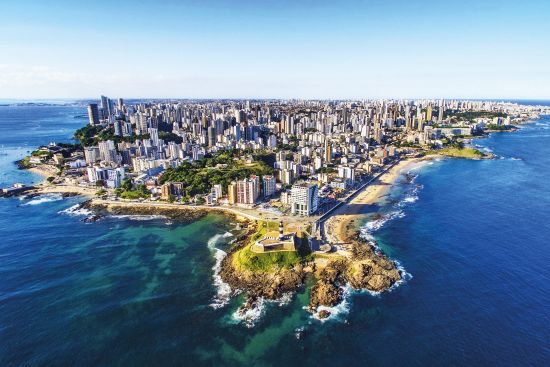
Founded by the Portuguese in 1549, Salvador was Brazil’s first capital, and you’ll find reminders of its colonial history everywhere you look. With majestic views of All Saints Bay, Salvador has long been divided into an upper and a lower city, separated by a 300ft cliff wall. The upper city formed the administrative, religious and primary residential districts, while the lower city was the commercial centre, with a thriving port and market.
The best way to explore is on foot. Start at the Centro Nautico tourist terminal, with the bay behind you, and right ahead you’ll see the Mercado Modelo, an impressive neoclassical building (and a great place to stop for inexpensive handicrafts on your way back).
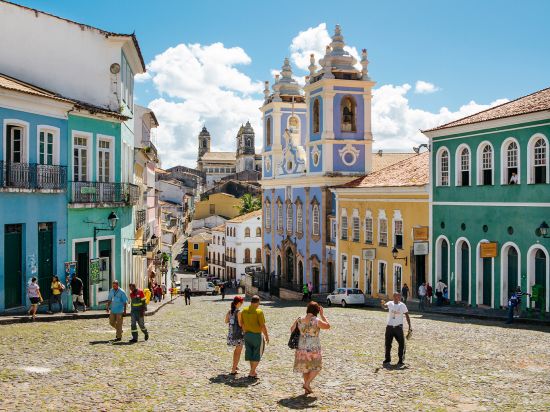
Just beyond is the facade of the upper city, and the art deco Elevador Lacerda – Brazil’s first urban elevator – which will take you there. Take a tip from the locals and stop off for a fresh green coconut juice to get some loose change for the ride.
Stepping out of the Lacerda into the square of Praça da Sé, with the modern mayoral office on one side and the impressive Rio Branco Palace on the other, pause to look back at the stunning vista of All Saints Bay, which leads to the Paraguaçu River and the inland area known as the Reconcavo.
A rich source of tobacco and sugar cane, this region explains why Salvador became one of the first slave ports in the Americas. The descendants of those abducted from modern-day Angola, Benin, Congo, Ethiopia, Nigeria, Senegal and Mozambique make the city a major focus for Afro-Brazilian culture, and you’ll see – and hear – this influence everywhere.
Now turn round and swing left toward Praça da Sé, passing the statue of Zumbi dos Palmares, an early leader in the slaves’ battle for freedom from their Portuguese captors. By now you’ll probably be wanting a rest, so follow your nose to Terreiro de Jesus plaza and the Pelourinho district – the heart of the Old City.
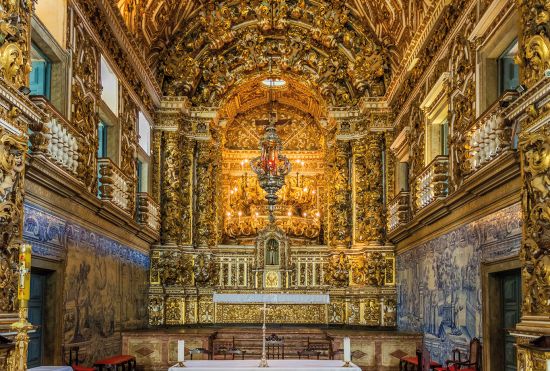
On your right, just as you enter the square, is a great traditional bar, O Cravinho. This is the perfect pitstop for a chilled beer or maybe a glass of the house special clove-based liquor. If you’re feeling peckish, they also do a perfect accompaniment in the form of camarao encapotada – succulent prawns in a delicious batter.
Pelourinho is named after the pillory or stocks once used for the public punishment of slaves. Long designated a UNESCO World Heritage Site, it’s a treasure trove of Portuguese colonial architecture and historic monuments, and there is much to see.
Before you leave Terreiro de Jesus, don’t miss one of Salvador’s best attractions – the Afro-Brazilian Museum (MAFRO). As well as many original artefacts, including jewellery, pottery and musical instruments, it also contains some incredible panels of sculpted wood by the celebrated local artist Carybé.
Salvador is packed with churches, and one of the best for tourists to visit is Sao Francisco. Here the gilded Portuguese baroque interiors are quite awe-inspiring – but if church-fatigue sets in, you’ll find a great little ice-cream vendor nearby (check out the funky local fruit flavours, such as umbu, siriguela and caja).
Walking down towards Largo de Pelourinho square (actually a triangle), you should stop off for another true taste of Brazil – the traditional mix of cachaça rum, crushed ice and fresh lime known as a caipirinha. Pelourinho is also home to Olodum, one of the first Afro-Bahian drumming groups, and a carnival favourite.
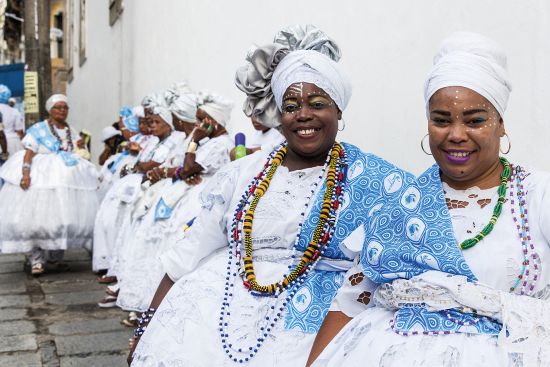
Hang around long enough and you’re also likely to see an impromptu performance of capoeira. Another influence from Africa, this ritualised hybrid of fighting and dance moves has strong cultural roots in Salvador, but its popularity has now spread worldwide.
As the cobbled square becomes steeper, stop to admire the church of Nossa Senhora do Rosario dos Pretos. Recently restored, this handsome structure embodies the history of the enslaved people who built it over many years from 1704.
Its name translates as the Church of Our Lady of the Rosary of Black People, and it played a seminal role as a place for those of African descent to worship freely in the days before slavery was abolished (Brazil was the last country to do this, in 1888). And although it is nominally Catholic, you’ll find the padre makes many references to a different theology altogether.
Salvador is synonymous with Candomblé, the religion that originated among the city’s slaves at the beginning of the 19th century. It developed as a mixture of beliefs brought from west and central Africa, wisely absorbing elements of Roman Catholicism, too.
Its presence is felt in most of the city’s festas or feast days throughout the year, such as Lavagem do Senhor do Bonfim in January, and Festa do Yemanja (Goddess of the Sea) in February. If you’re fortunate enough to be visiting then, you’ll see hundreds of thousands of Bahians all wearing white and making floral offerings.
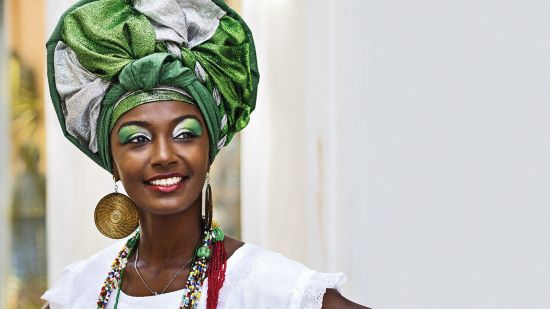
Your next stop should be Santo Antonio, the neighbourhood immediately to the north of Largo do Pelourinho. If you’re not churched out by now, pop into Santo Antonio Alem do Carmo, where you’ll find a splendid cedar carving of Christ, inlaid with 2,000 rubies, each representing drops of blood.
Just after you pass a former convent, now transformed into a hotel (Pestana Convento do Carmo), the street leads to Santo Antonio proper. From here, a quick trip on the Pilar funicular railway will give you some great photo opportunities of the commercial district and port below.
Santo Antonio has a laid-back, artistic vibe, with indie cafes, vintage clothing stores and pastel-coloured townhouses along its main street (Rua Direita), which offers some excellent restaurants, too. One local favourite is Poro (just past the Convento hotel).
If your appetite tempts you inside, start with a great tropical salad, then follow up with either a classic moqueca (fish stew cooked in palm oil with coconut milk) or fish fillet, yam and vatapa (bread, shrimp, coconut milk, finely ground peanuts and palm oil, mashed into a creamy paste).
Time now to head back towards your ship, but try to factor in one last stop. Find a bar on the port side of the road, head to the rear and pick a table overlooking the bay. Now you can watch the sun set, and maybe remind yourself one last time how good those caipirinhas taste.
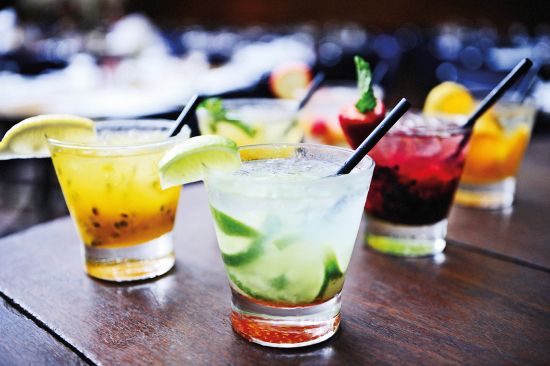
In the know
When to go
Salvador has a tropical climate so it can be rainy, but it’s drier (and hotter) in January and February.
Getting around
Cruises arrive at Salvador Port, from where you can start a walking tour. The streets of Pelourinho and Santa Antonio are compact enough to explore on foot, but taxis are plentiful and cheap.
Currency
The Brazilian currency is the real, but you can pay for a lot of things in US dollars, and all the major sites and restaurants accept credit cards.
Sightseeing & restaurants
Take a cab to Bonfim Church (30 mins) and then on to Ribeira (another 15 mins) for panoramic views of the harbour, and sensational ice cream at Sorveteria da Ribeira (87 Praça General Osorio). For amazing local food and great music at the weekend, try Espaço d’Venetta (12 Rua dos Adobes). For drinks, the art deco Fera Palace Hotel (20 Rua Chile) has a great cocktail bar on the roof.
Get on board
17-night ‘Grand voyage’ aboard MSC Preziosa, from Southampton to Rio de Janeiro via Lanzarote and Salvador, departing 28 October 2020, from £929, msccruises.co.uk
12-night ‘Brazil & Portugal’ cruise aboard Celebrity Silhouette, from Rio to Lisbon via Salvador and Tenerife, departing 7 April 2021, from £1,219, celebritycruises.com
Asian Wonders & Arabian Delights
- 20 nights, departs on the 05 Apr 2024
- Regent Seven Seas Cruises, Seven Seas Navigator
- Laem Chabang, Laem Chabang, Ko Samui, + 18 more
North Pacific Passage
- 18 nights, departs on the 13 Apr 2024
- Regent Seven Seas Cruises, Seven Seas Explorer
- Tokyo, Hitachinaka, Miyako, Iwate, + 16 more
Whale Watching Expedition
- 7 nights, departs on the 01 May 2024
- Regent Seven Seas Cruises, Seven Seas Explorer
- Vancouver, British Columbia, , Ketchikan, Alaska, + 5 more
Ocean Air & Spanish Flair
- 14 nights, departs on the 10 Apr 2024
- Regent Seven Seas Cruises, Seven Seas Grandeur
- New York, New York, , Kings Wharf, + 12 more
